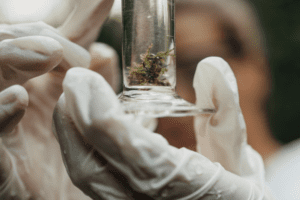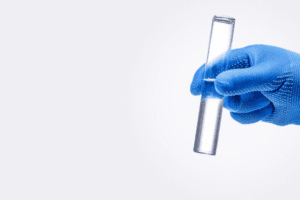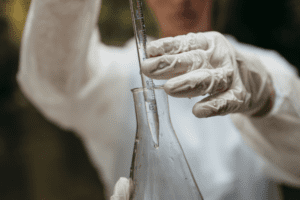
If you're like most people, you probably don't think about water quality until there's a problem. By then it's often too late. Water contamination can cause all sorts of health problems, so it's important to be able to read a water quality test and understand what the results mean. In this article, Oak Plumbing will discuss the different types of water quality tests and what each one measures. We'll also explain how to interpret the results so that you can take appropriate action if your water quality test finds contamination.

Water Quality Test Types to Identify Contaminants
- Bacteria. While coliform bacteria by itself is usually not harmful, it indicates the possible presence of disease-causing bacteria stemming from human or animal waste.
- Nitrate. Nitrate is a form of nitrogen that, when introduced to groundwater by humans, can be deadly for infants six months or younger. Nitrates often signal the presence of other dangerous contaminants in the water.
- Lead. Lead in water is a serious health hazard, and it can come from lead pipes or solder.
- Alkalinity. The measurement needed to determine the level of corrosion.
- Chloride. High concentrations usually show that the area has been contaminated by things such as a septic system, fertilizer, landfill, or road salt.
- Conductivity. Electrical conductivity is the measure of how well water can carry an electrical current. This property can be used to determine if there are any contaminants present in the water.
- Corrosivity Index. Several tests indicate that water tends to corrode plumbing or form lime deposits in pipes.
- Hardness. This product helps you determine if water softening is necessary, and also determines the corrosivity of your water.
- Ph. Indicates water's acidity and helps determine if water will corrode plumbing.
Initial tests should always be run for bacteria, and it's recommended that users test annually. For nitrate, it's a good idea to conduct several annual tests; if levels are low, however, yearly testing is not necessary. The only time an exception to this would be if an infant was consuming the water.

What are parts per million?
Laboratory equipment is precise and can identify water contaminants at levels as low as parts per million (ppm) or even parts per billion (ppb). For example, one part per million can be imagined as one red marble mixed in with 999,999 blue marbles. This is also equivalent to one inch in sixteen miles or a minute in two years. Some chemicals only need to be present in very minute quantities- even one part per billion or less- to cause harmful health effects.

What the Results Mean
Use the data below as a starting point to better understand your well water quality, which is indicated by an initial water test. It's important to know how to interpret these results because they can give you a good overview of your well water quality. Usually, test results are given in milligrams per liter (mg/1) or micrograms per liter (µg/l). For example, a water test might indicate that the water contains 6 mg/l nitrate. This means that a liter of water contains an average concentration of 6 milligrams of nitrate. Also, note that one mg/l is equivalent to one part per million (ppm). One µg/l equals one billionth (part per billion or ppb) of a gram. All of this is essential to understanding your water quality test.

Coliform Bacteria
Although they are not typically harmful, coliform bacteria can be an indicator that waste is contaminating surface water sources. If human or animal fecal matter is present, it could lead to the spread of diseases like gastrointestinal illnesses or hepatitis.
Acceptable Results: 0 coliform/100 milliliters (ml) of water (also called 0/5). If you have any coliform colonies in your water sample, you should retake the sample. If a second test comes back positive for coliform, take corrective action immediately.

Nitrate
Nitrate nitrogen is a commonly used lawn and agricultural fertilizer, as well as a chemical found in decaying matter. If infants who are six months old or younger drink water with more than 10 ppm nitrate-nitrogen, they could develop methemoglobinemia. This disease hampers the blood's ability to transport oxygen. High nitrate levels indicate that other pollutants might be present. Nitrite is an unstable form of nitrogen that may be found in minuscule amounts with nitrate. Sometimes results for both nitrate and nitrite are reported simultaneously.
Acceptable Results: Labs report nitrate results either as nitrate nitrogen or as nitrite and nitrate nitrogen. When reported as nitrate nitrogen (NO3-N) or nitrate and nitrite nitrogen (NO2 + NO3-N) the acceptable level is less than 10 mg/l (less than 2 mg/l is preferred). When reported simply as nitrate (NO3), the acceptable level is less than 45 mg/l.
Sources: Nitrate levels can become elevated due to a variety of factors, such as fertilizer, septic system effluent, animal wastes, and landfills. In most cases, this signifies that the aquifer (water-bearing formation) has been contaminated at that depth.

Lead
Lead is a poisonous metal that can cause injuries to the brain, kidneys, nervous system, red blood cells and reproductive system. Nevertheless, this heavy element presents a greater Health hazard to young children than to adults. Drinking water contaminated with lead continues to be a significant health hazard in many residences constructed before 1985 where copper water pipes were soldered together with solder containing lead. Homes with soft water are most susceptible to having drinking water supply contaminated by lead leaching from the solder into the tap water.
Acceptable Results: less than 15 µg/l (parts per billion) lead.
Sources: There are three main sources of lead in drinking water: solder in copper pipes, lead pipes, or service connections.

Chloride
Generally, chloride in groundwater is 10 mg/l or less. In some cases, however, such as limestone and sandstone aquifers, higher concentrations may be natural. If the concentration is much higher than usual, it's likely due to contamination by septic systems, road salt runoff from melting snow, fertilizer, and animal waste. Although chloride itself isn't poisonous, too much of it can make your water taste salty. High chloride levels also have a corrosive effect on plumbing similar to what road salts do to cars.
Acceptable Results: There is no health standard. Levels less than 10 mg/l are desirable. Levels of more than 250 mg/l may cause a salty taste.
Sources: Septic systems, road salt, fertilizer, animal or other wastes.

Conductivity
Conductivity (specific conductance) is a measurement of how well water can carry an electrical current, which is indirectly proportional to the amount of dissolved minerals in the liquid. This does not give an indication of what type Conductivity (measured in µmho/cm at 25˚C) usually equals approximately twice the hardness (mg CaCO3/l) for most pure waters. If it exceeds this number by a considerable margin, it could signify that there are chemical contaminants such as sodium, chloride or sulfate present; these may arise from either natural causes or human activity. Rising or falling conductivity in water may signify a change in water quality.
Acceptable Results: There is no standard for what constitutes healthy water conductivity. A general rule of thumb, however, is that the hardness in unsoftened water should be roughly double the desired level of conductivity.
Sources: Dissolved substances in the water, both natural and man-made.

pH
The hydrogen ion (acid) concentration in water is called pH. A pH of 7 is neutral, with values above 7 being alkaline or basic, and those below 7 being acidic. Though a small change, each 1 unit difference in pH corresponds to a 10x change in acidity levels. Because of this high level of corrosiveness, iron may also be found at problematically high concentrations in acidic water. However, it's important to keep in mind that the laboratory-tested pH values are often slightly higher than what would actually be found at your well site.
Acceptable Results: There is no one-size-fits-all when it comes to water pH levels. In most natural waters, the pH level falls somewhere between 6.5 and 8.5 on the scale. The lower the pH, the more corrosive the water will be.
Sources: Low values typically result from a lack of carbonate minerals, including calcium and magnesium. Another potential reason for low pH readings is water leaking from a landfill.

Alkalinity
Alkalinity indicates how well water can buffet acids, and is tied to pH. This feature comes mostly from calcium carbonate minerals - such as limestone - disintegrating in the aquifer. When alkalinity and hardness are both mentioned in relation to the concentration of calcium carbonate, they're often nearly identical because they come from the same sources. If you test an unsoftened sample and find that the alkalinity is much higher than the total hardness, consider testing for sodium. If, however, you find that the alkalinity is much lower than the total hardness, test for chloride, nitrate, and sulfate instead. Additionally, keep in mind that water with low alkalinity (less than 150 mg/l) is more likely to be corrosive. Lastly, water with high alkalinity (greater than 150 mg/l) may cause scale buildup in plumbing over time.
Acceptable Results: If the corrosivity index is satisfactory, values near 150 are considered ideal. If expressed as mg/l CaCO3, the value should be similar to hardness (between 75 to 100 percent of the hardness value).
Sources: The vast majority of limestone minerals come from decomposing soil and rocks.

